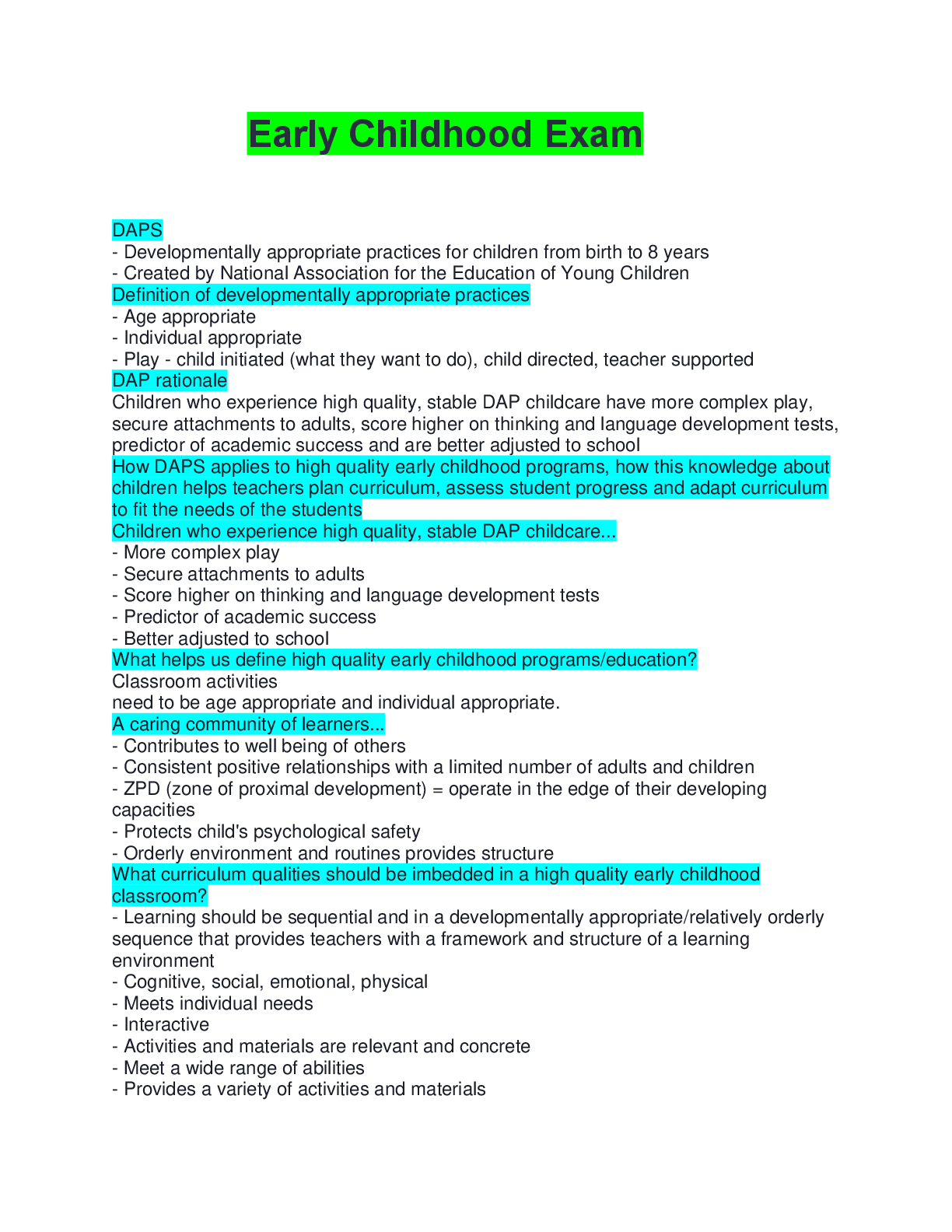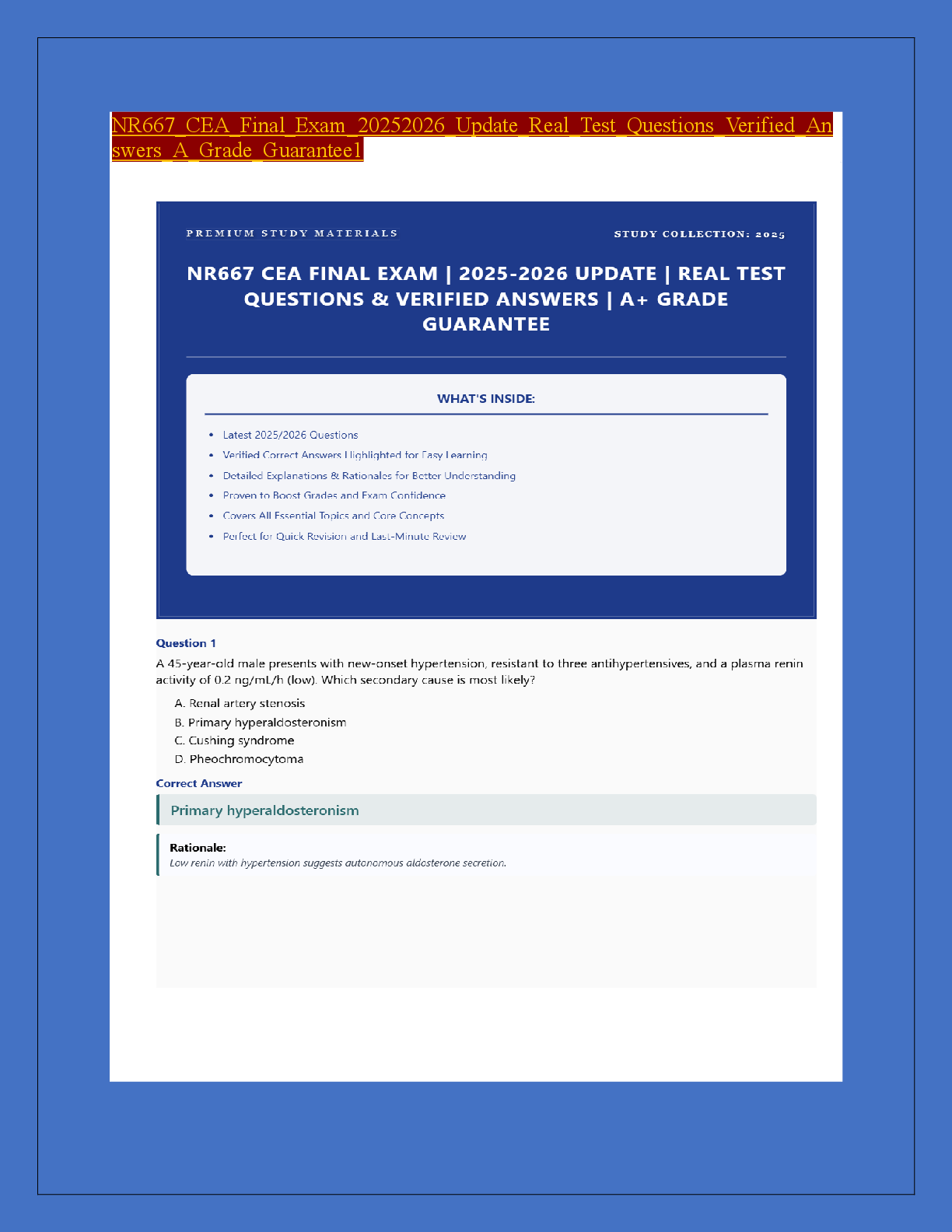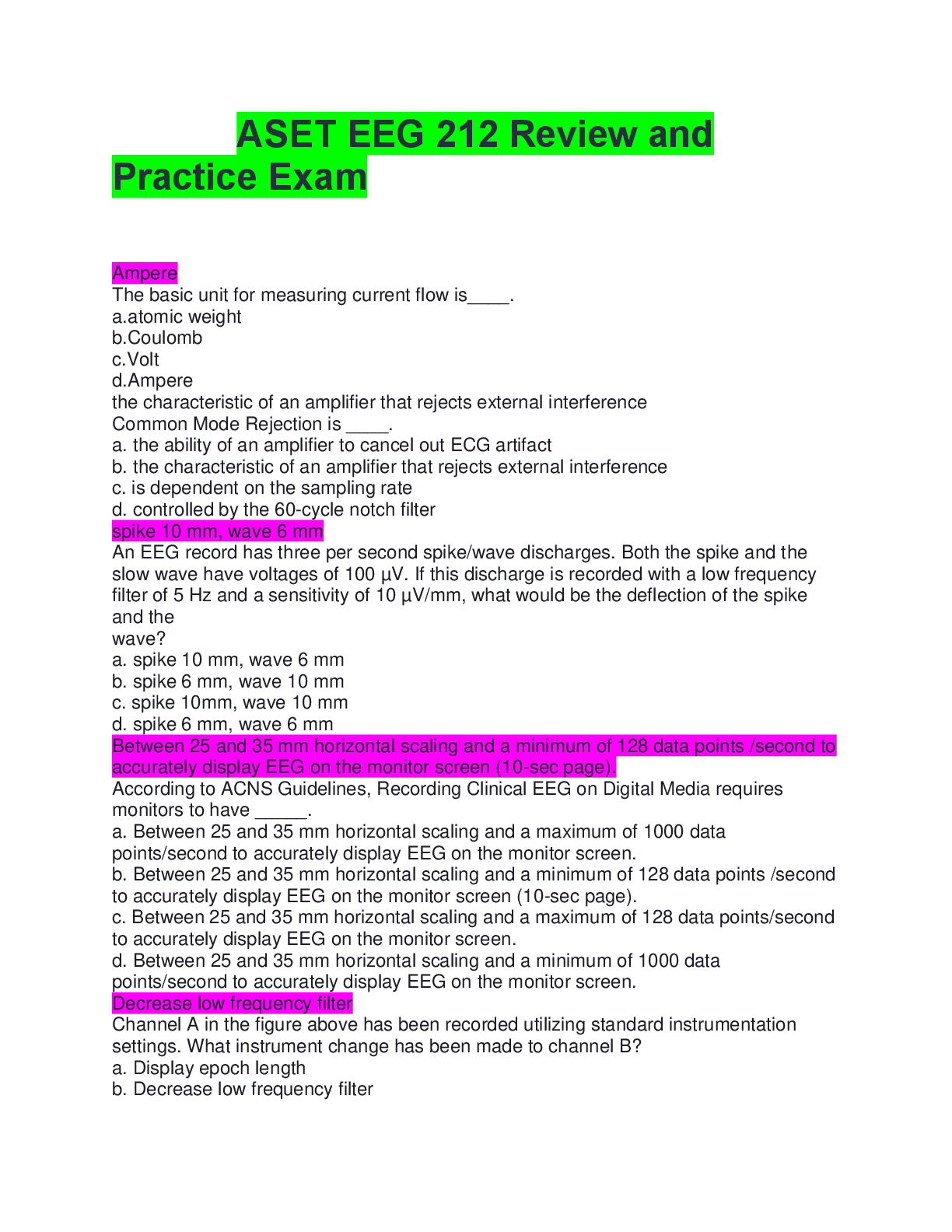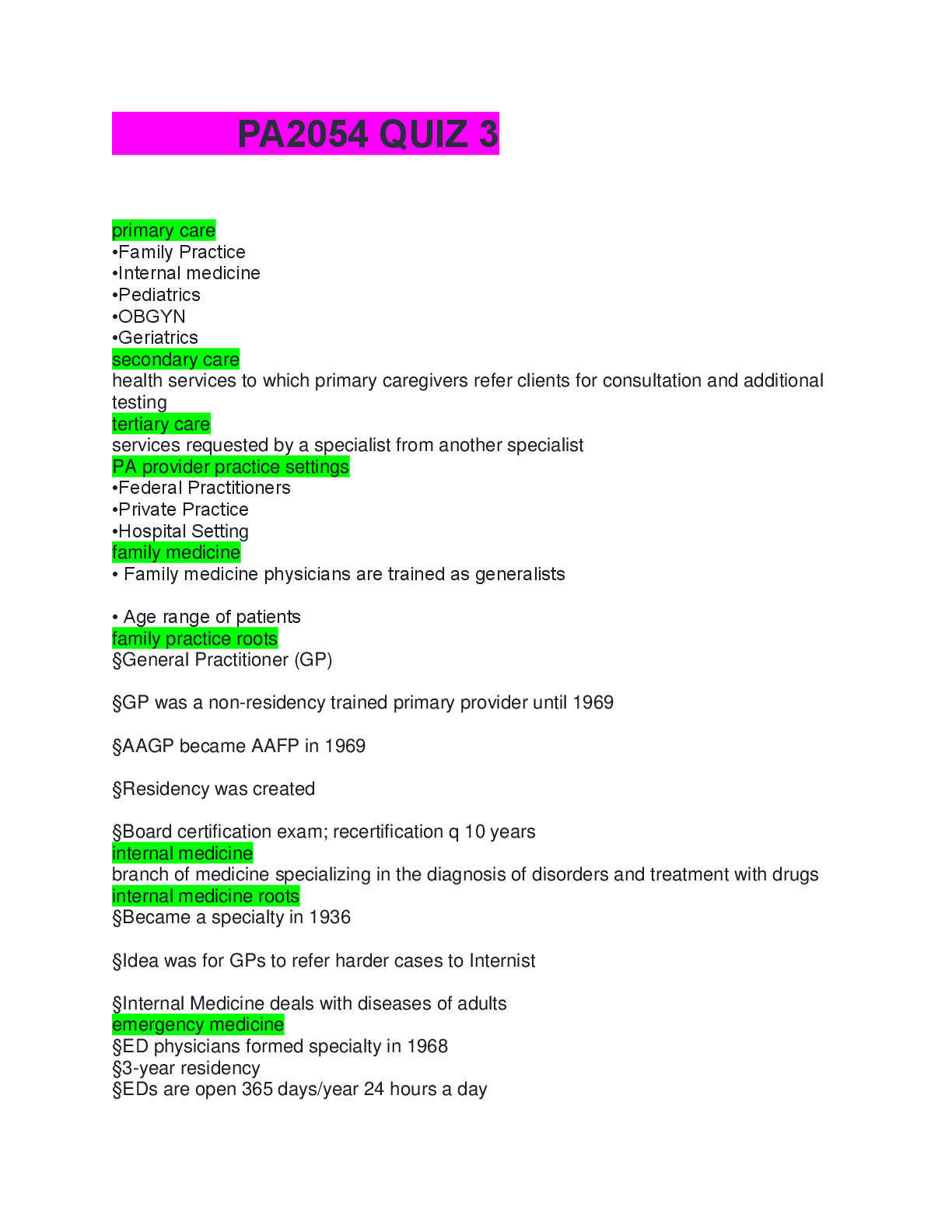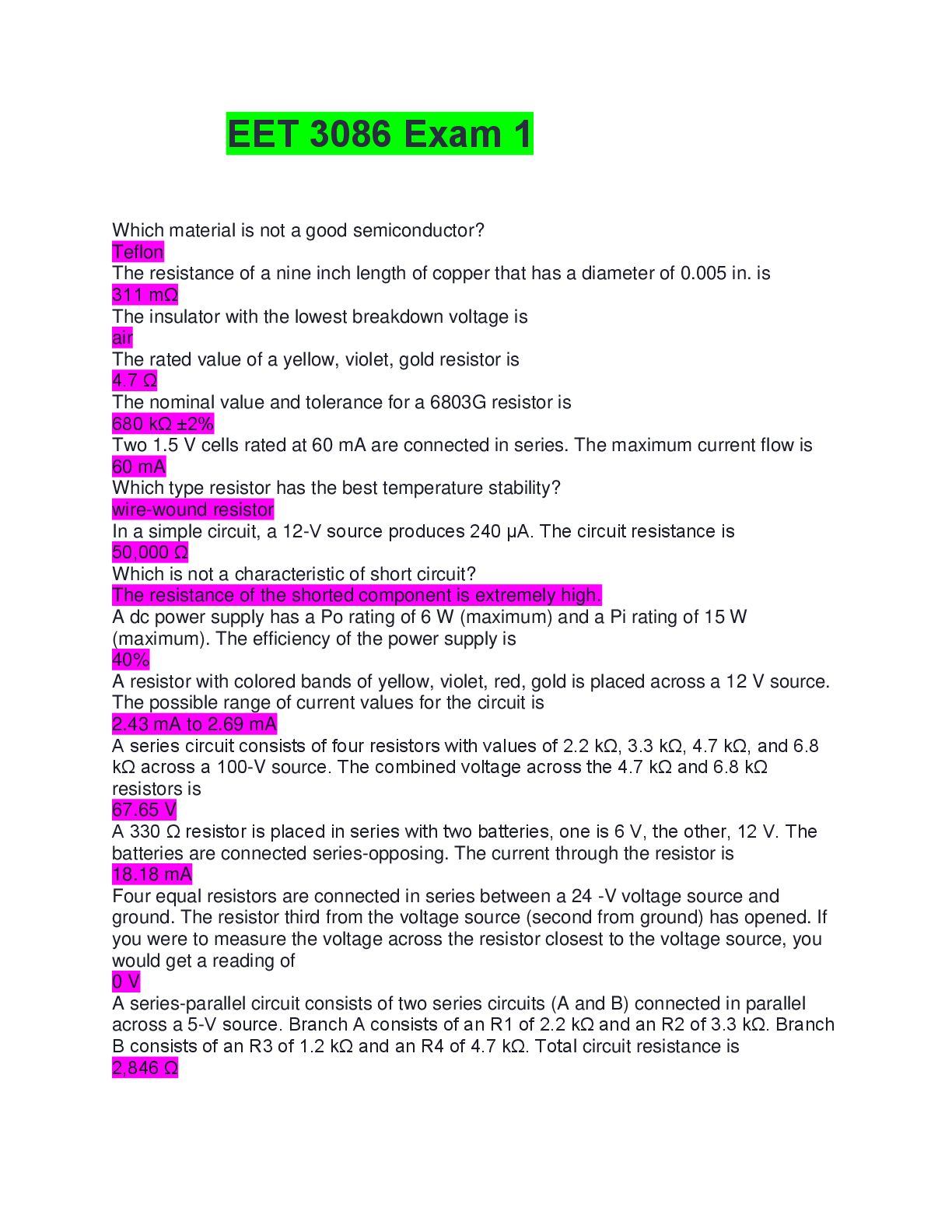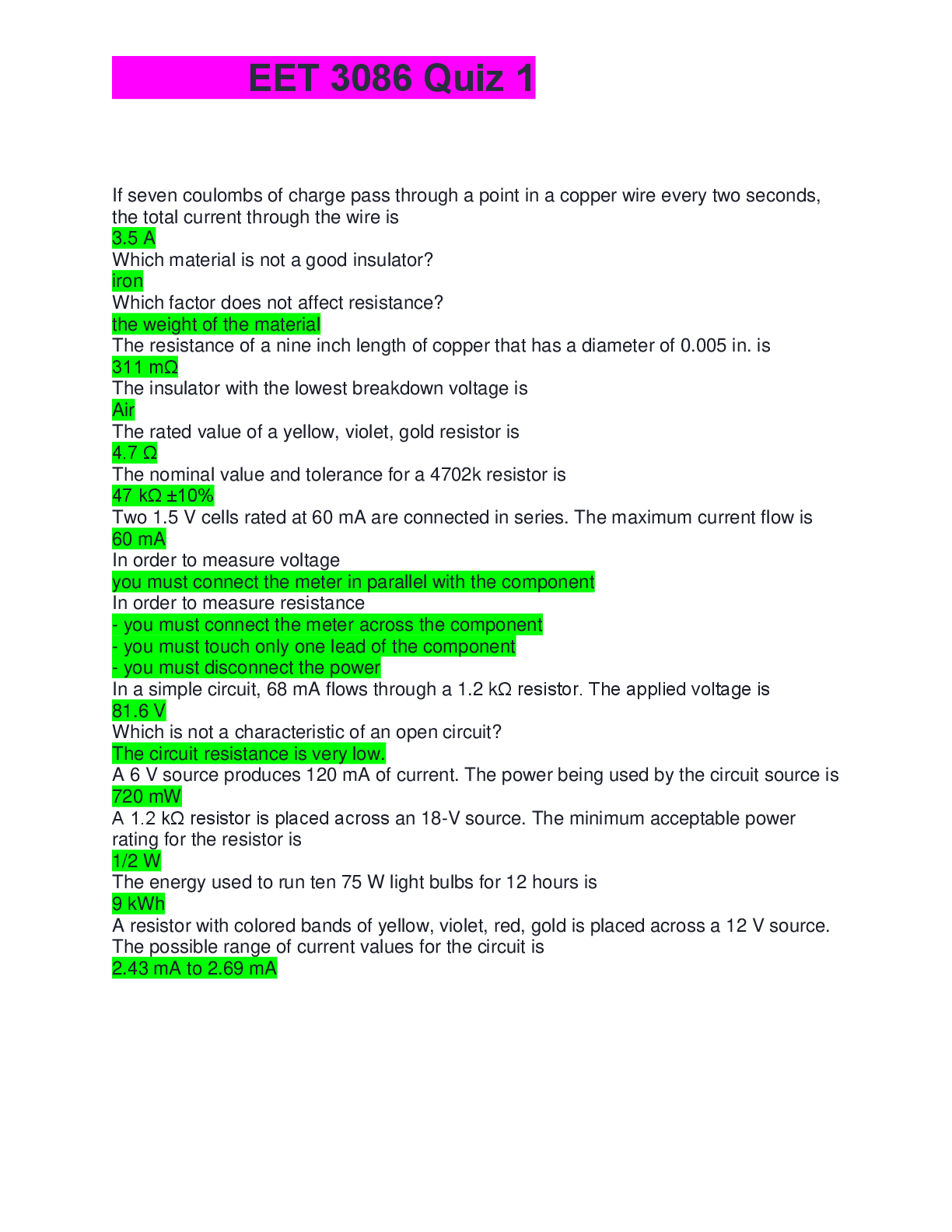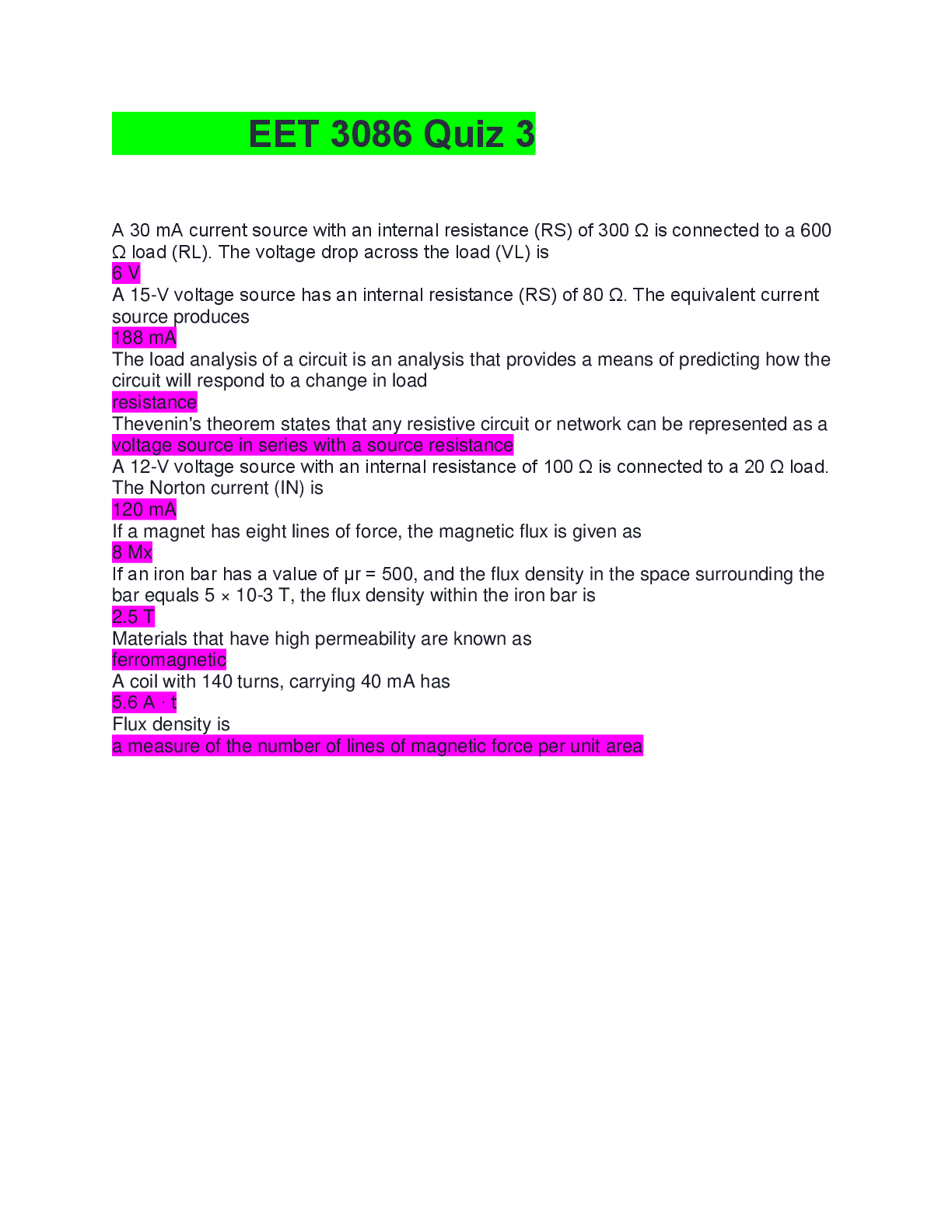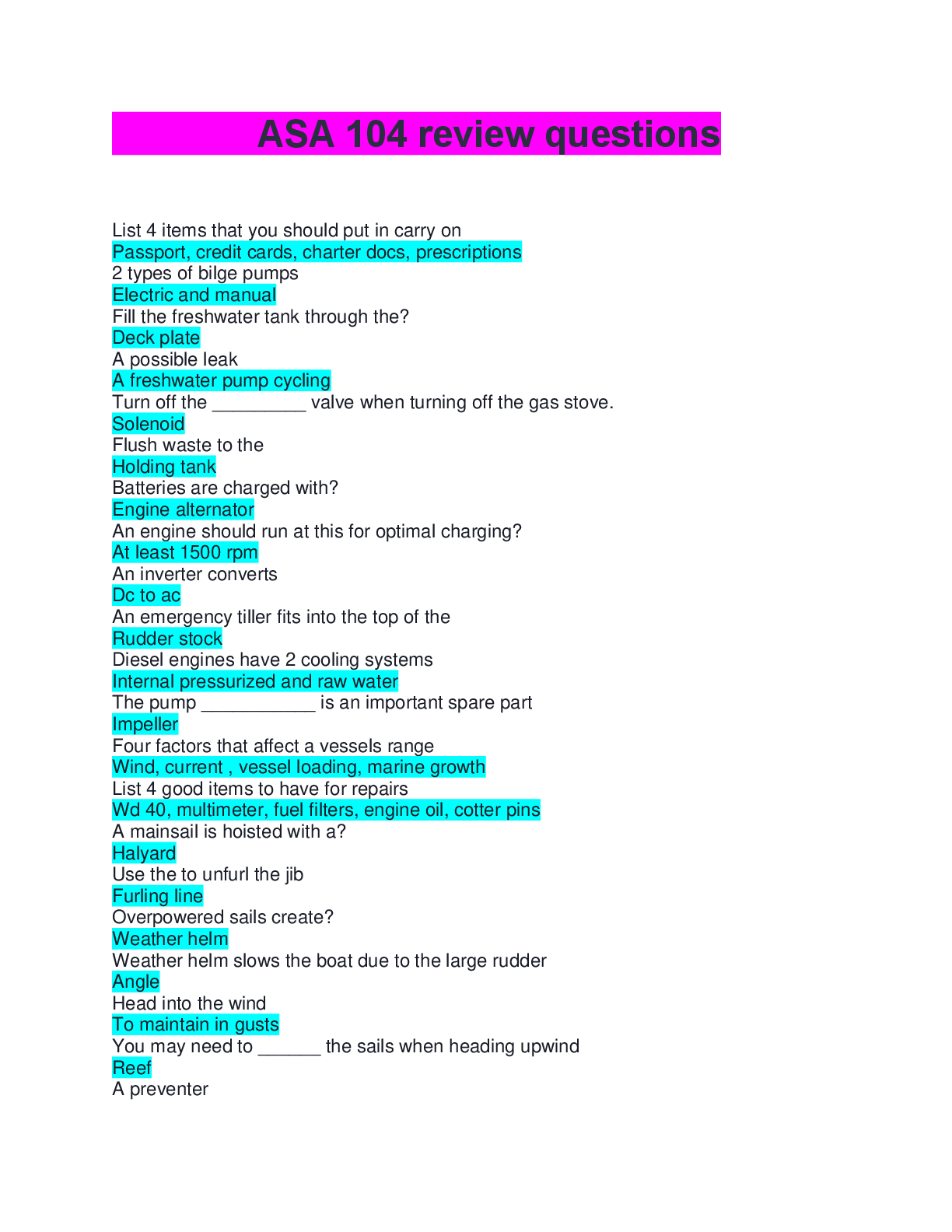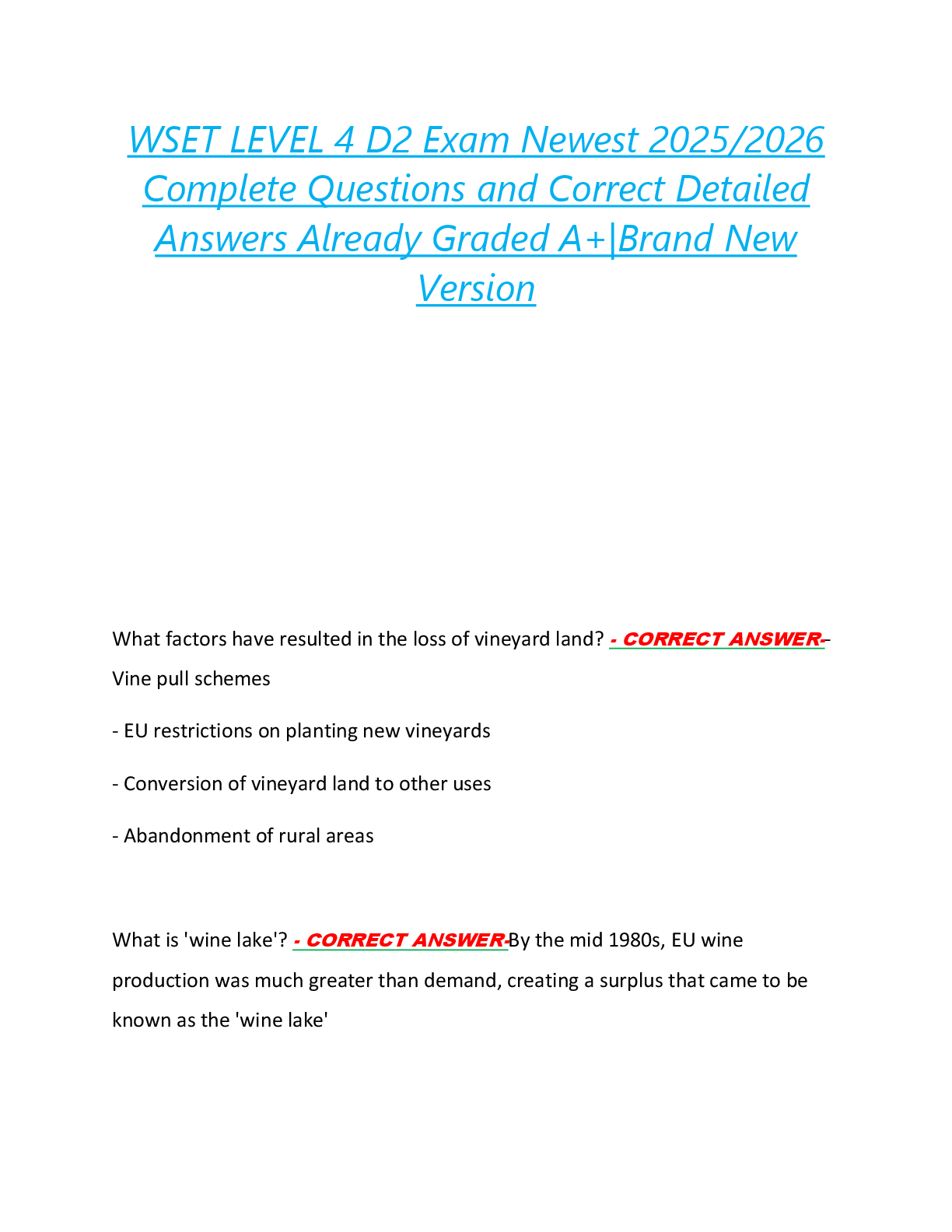Management > EXAM > MN566 Unit 5 Midterm Exam / MN 566 Unit 5 Midterm Exam (Latest): Kaplan University (Already graded A (All)
MN566 Unit 5 Midterm Exam / MN 566 Unit 5 Midterm Exam (Latest): Kaplan University (Already graded A)
Document Content and Description Below
MN566 Unit 5 Midterm / MN 566 Unit 5 Midterm/ MN566 Week 5 Quiz (Latest) : Kaplan University Question 1 The practical application of findings from a set of studies is known as: Question options: criti ... cal analysis. data implementation. guideline development. research utilization. Question 2 It is always important to consider the pathological process that could be causing the patients problems. Choose all that should be considered when creating your differential list using a mnemonic.. Question options: Inflammatory Neoplastic toxic or metabolic infectious congenital traumatic Question 3 Which of the following would be considered the research design for Level VI evidence? Question options: Systematic reviews of descriptive or qualitative studies Opinion of authorities and expert committees Well-designed case control or cohort studies Single descriptive or qualitative study Question 4 Different kinds of thinking and learning also include the Affective Domain. This model described by Krathwohl (1964), is : Question options: Complex to include conceptual knowledge A metacognitive model Based on an organized hierarchy Based on an individual's commitment to living and valuing Question 5 The Goals of Diagnostic Reasoning is to:(choose all that apply) Question options: Solve a problem establish a relationship with your patient screen for disease and illness promote healthy lifestyles support research Question 6 Choose all the following that are essential in developing clinical practice guidelines: Question options: Identification of A topic Enlist and expert panal Review of literature 'D. Rate evidence Draft a proposal External review of draft Revised draft based on recommendations Question 7 Indicators that a headache can be the presenting symptom of a serious illness and may require neuroimaging include all the following except: Question options: Headaches that occur periodically in clusters Increase frequency and severity of headaches Headaches causing confusion, dizziness and or lack of coordination. Headaches causing you to wake at night. Question 8 Understanding other factors that can be causing the patients problems include:. Choose all that should be considered Question options: Demographics Age Gender weight medications education Question 9 The Symptom Management Model proposes to consider three dimensions as an advanced practice approach to care. Choose the three dimensions that are suggested. Question options: The symptom experience The past medical history Symptom Outcomes Symptom management strategies Question 10 Bloom’s (1956) taxonomies of learning includes all of the following except: Question options: the cognitive domain the communication and leadership domain the affective domain psychomotor domain Question 11 Which of the following would be considered the research design for Level II evidence? Question options: Single descriptive or qualitative study Well-designed case control or cohort studies Single, well-designed, randomized clinical trial Systematic review of randomized clinical trial studies Question 12 Treatment options in cluster headaches include the use of Question options: Nonsteroidal antiinflammatorydrugs(NSAIDS) oxygen Triptans All of the Above Question 13 Formulating your differential diagnosis is a process that includes: Question options: Diagnostic tests "shot-gun" finding A physical History of the present illness Your personal experiences Critical Thinking Question 14 Practice Standards are designed to be flexible and can be tailored to be used in any medical arena. Question options: True False Question 15 Which of the following would be considered the research design for Level IV evidence? Question options: Single descriptive or qualitative study Opinion of authorities and expert committees Systematic review of randomized clinical trial studies Well-designed controlled trials without randomization Well-designed case control or cohort studies Question 16 Diagnostic test should be the deciding factor when making your final diagnosis. Question options: True False Question 17 Which is the most important question to ask in nursing research? Question options: What findings constitute evidence? How will the findings be used? Is this a randomized controlled trial? What theory is being utilized? Question 18 Using mnemonics for gathering a health history can be helpful when trying to analyse the symptoms presented and create a differential list.Which mnemonic will give you the most comprehensive approach to collecting your history? Question options: OLDCARS COLDSPA MEDLIST OLDCARTS Question 19 Applying evidence at the point of care requires: Question options: Readily available evidence-based resources Ability to review research literature Single articles in journals Current textbooks Question 20 Which of the following would be considered the research design for Level V evidence? Question options: Systematic review of randomized clinical trial studies Well-designed controlled trials without randomization Systematic reviews of descriptive or qualitative studies Single descriptive or qualitative study Question 21 Identify the choice that best completes the statement or answers the question. Which of the following are parts of evidence-based practice? Question options: Clinician Patient Evidence All of the above Question 22 A 37 year old man that was diagnosed with cluster headaches and takes high doses of aspirin. Indicate the appropriate course of action : Question options: head CT head MRI C. neither for the following patient. All of the above Question 23 0 / 1 point What are the questions you should ask yourself before using clinical guidelines in your practice? All are correct except (mark the ones that apply) Question options: How strong are the recommendations Are the guidelines applicable to my patients Can I get reimbursed for using these guidelines Are the guidelines clinically important Are these guidelines from a reliable source How old are these guidelines Question 24 Which of the following would be considered the research design for Level I evidence? Question options: Single, well-designed randomized clinical trial Systematic review of randomized clinical trial studies Well-designed controlled trials without randomization Systematic reviews of descriptive or qualitative studies Question 25 The Circle of Caring Model has grown out of and is rooted in the assumption that caring is the central concept in nursing and is uniquely known and expressed in nursing. Question options: True False [Show More]
Last updated: 3 years ago
Preview 1 out of 8 pages
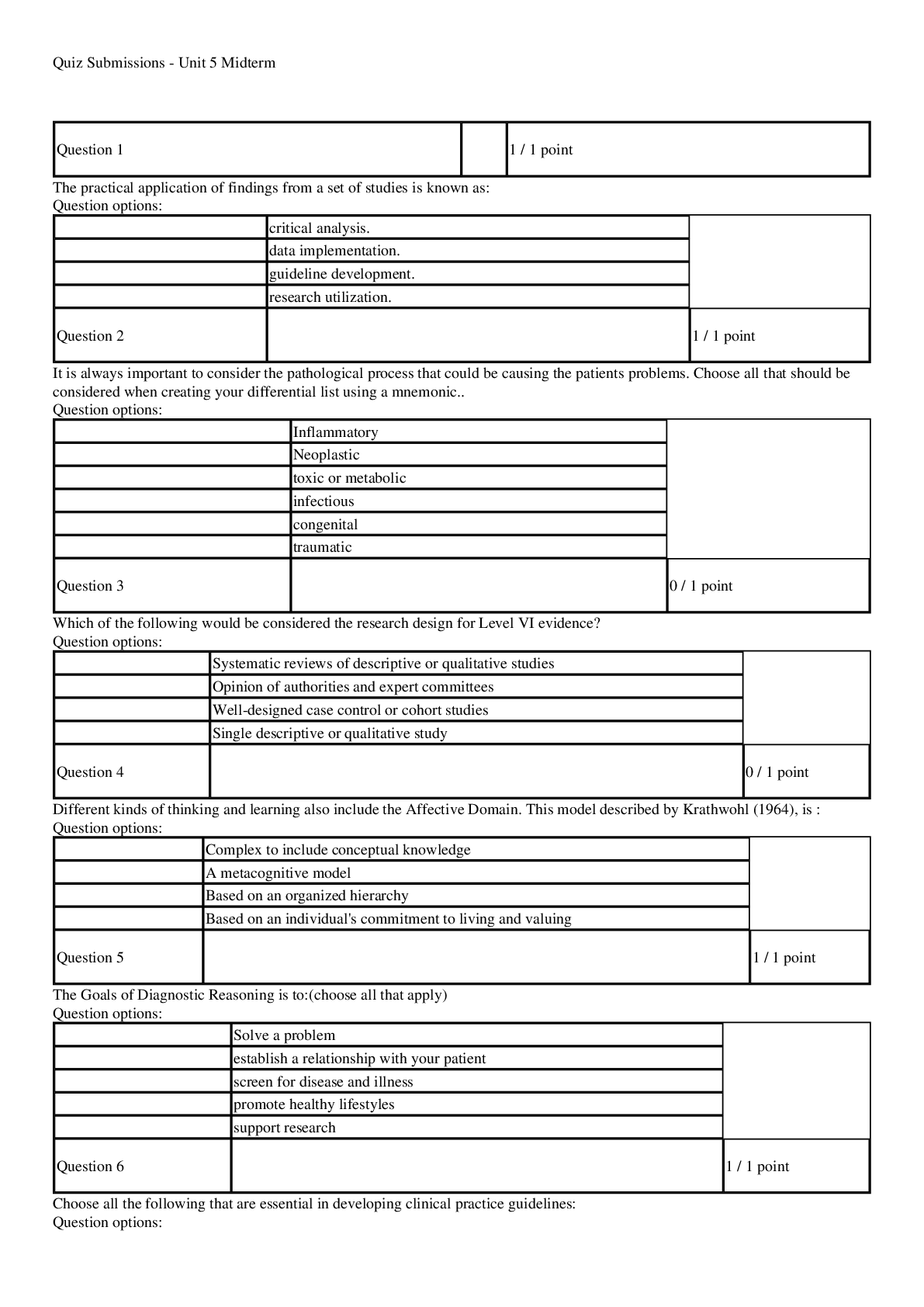
Buy this document to get the full access instantly
Instant Download Access after purchase
Buy NowInstant download
We Accept:

Reviews( 0 )
$20.00
Can't find what you want? Try our AI powered Search
Document information
Connected school, study & course
About the document
Uploaded On
Apr 27, 2020
Number of pages
8
Written in
All
Additional information
This document has been written for:
Uploaded
Apr 27, 2020
Downloads
0
Views
187













